
LionsDive
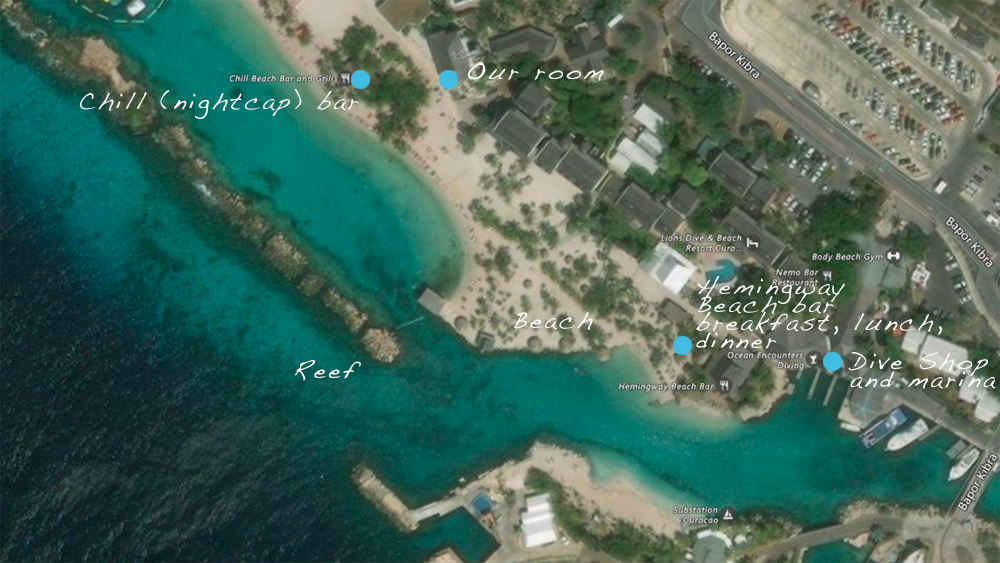
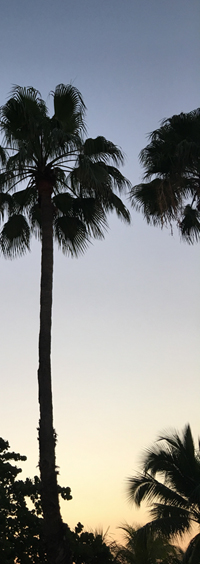
Our first beach, first resort, and first diving vacation. all rolled into one. Escaped on one of the first flights out of Logan after an all-day Friday Nor' Easter grounded pretty much everything the previous day. It was like living on a Disney set: the world in miniature, and meticulously manicured and clean. The tiny inlet that lead to the dive boat marina was barely wide enough for the boats to navigate, but the bottom dropped away so sharply that depth was not a problem. The beach that separated the marina from the breakwater could be swum, never mind walked, in three or four minutes. This was definitely worth doing, because the breakwater was a coral reef.
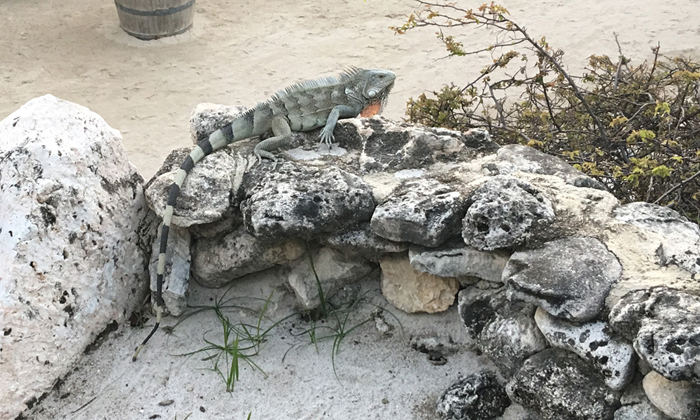
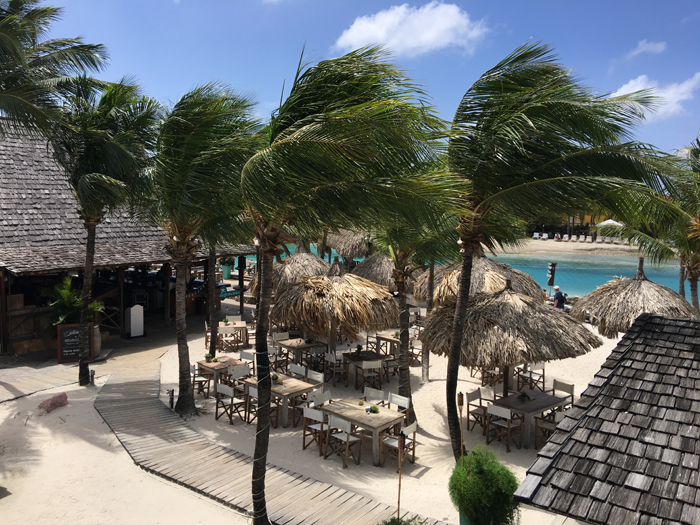
It was a three minute walk from our room to the marina, and the beach bar where we ate breakfast and many other meals besides was between the two. Our room was 50 yards from the water, and between them was the Chill bar ("No shirt, no shoes, no problem.") I went down there for a night cap on several occassions.
Only twice did we stray from the resort. Once early on to buy some groceries. We took a cab and persuaded the driver to wait for us and then bring us back. We told him where we wanted to go. "That's the Chinese supermarket. Are you sure you would not rather that I took you to the the Dutch supermaket? Same price." The Dutch supermarket was excellent. We came home with gluten-free bread, salad fixings, snacks, and a couple of bottles of wine.
Our second excursion was on the last day, when there was no diving, but also half a day before we were due at the airport. Our brief encounter with Willemstad is documented at the bottom of the page.
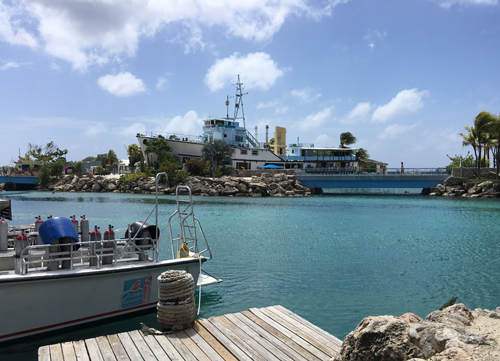 |
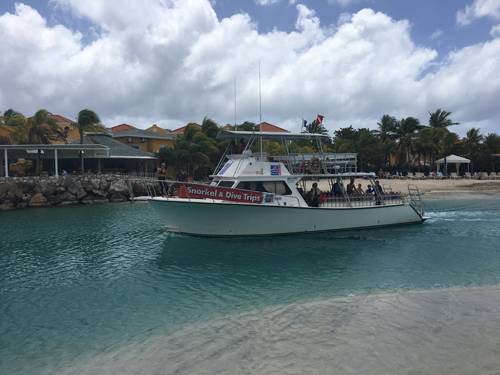 |
Diving
The sole purpose of this trip was to dive. The sole activity on this this trip was diving. Morning noon and night for many. Participants dove off the boat in the morning, came home, had some lunch, then grabbed new tanks and swam off the beach all afternoon. The group reconvened for dinner, and then a bunch of them returned to the dive shop to collect yet more tanks for a night dive. Rinse and repeat.
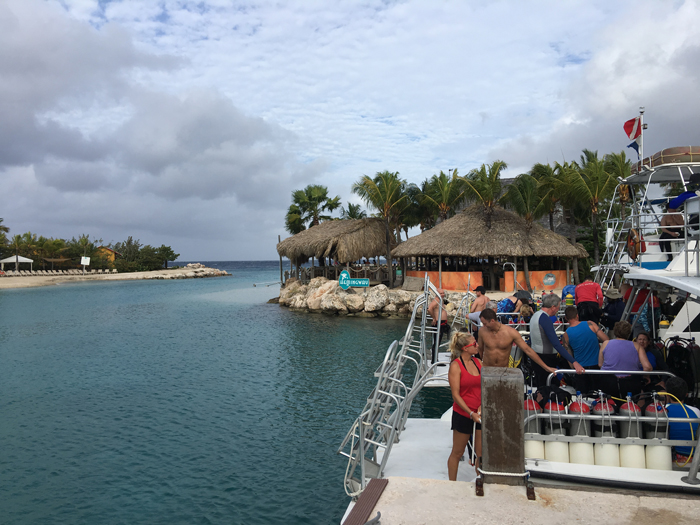 ... |
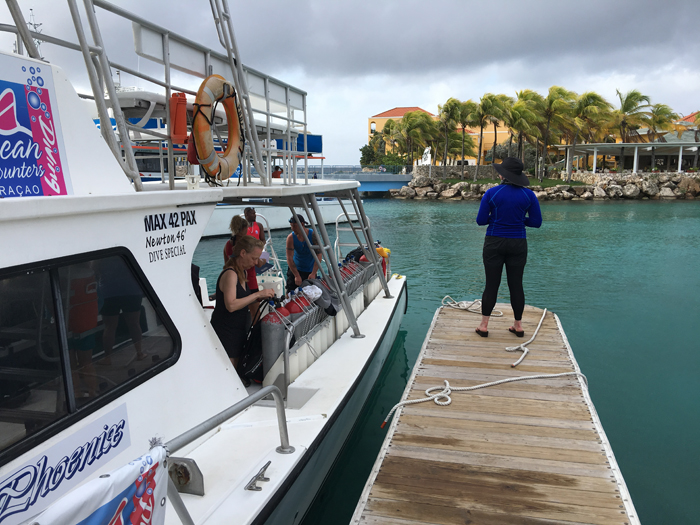
... |
The first day was spectacular—mirror-smooth seas, three different dive sites. Each dive started with a lesson with Laura, and the then rest of the tank was used up diving like the grown-ups. It turns out the lessons are easy, and mostly stuff most divers face in a life-time of diving, like taking off your BCD (Buoyancy Control Device—a life jacket which you can let the air in and out of) and putting it back on again, What the instructor really cares about is whether or not you can maintain bouyancy. Can you go to, say, 25 feet, and just hang there? That's not so easy, especially when the bubbles of air in the BCD shift their position and you suddenly start floating upwards ass-first, like Pooh tied to his balloons. But until and unless you can just hang at the required depth, the instructor can't take her eyes off you, and until she can do that she's not having any fun, and you are not going to get certified. Monitoring the amount of air left in your tank is the next most important thing, and after I was once asked how much I had left and discovered it was high time I booked it back to the boat, I didn't need that lesson again.
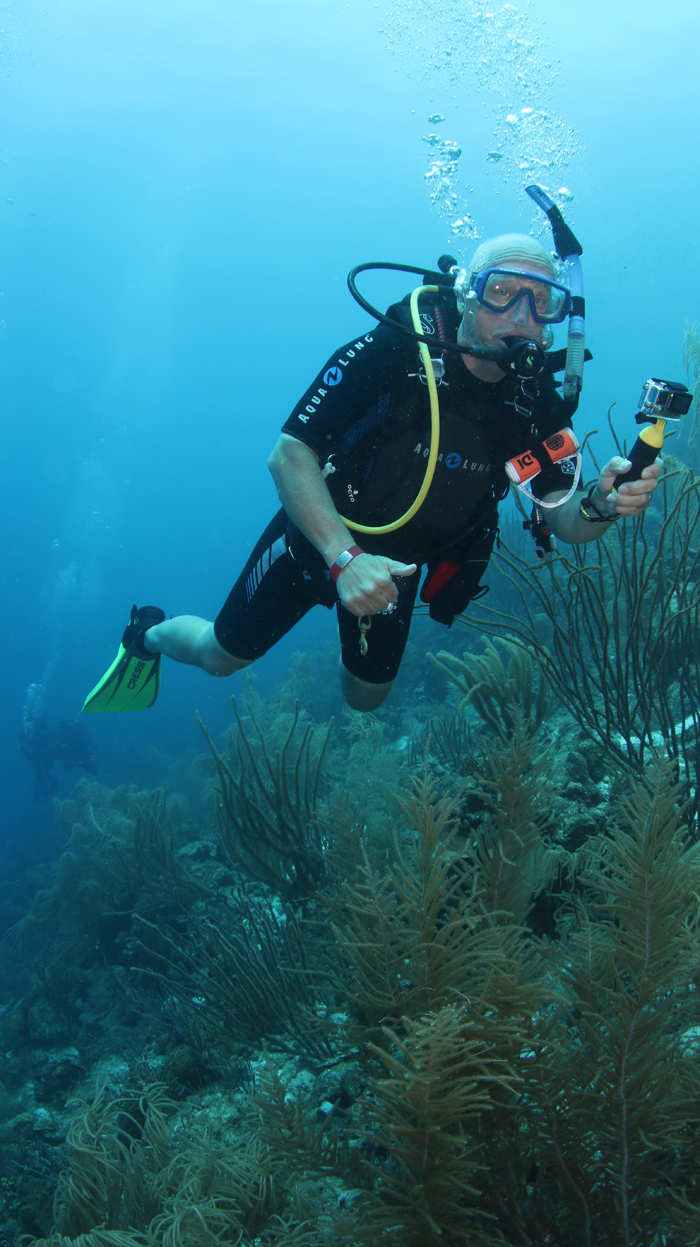 Photos courtesy Turtle and Ray. |
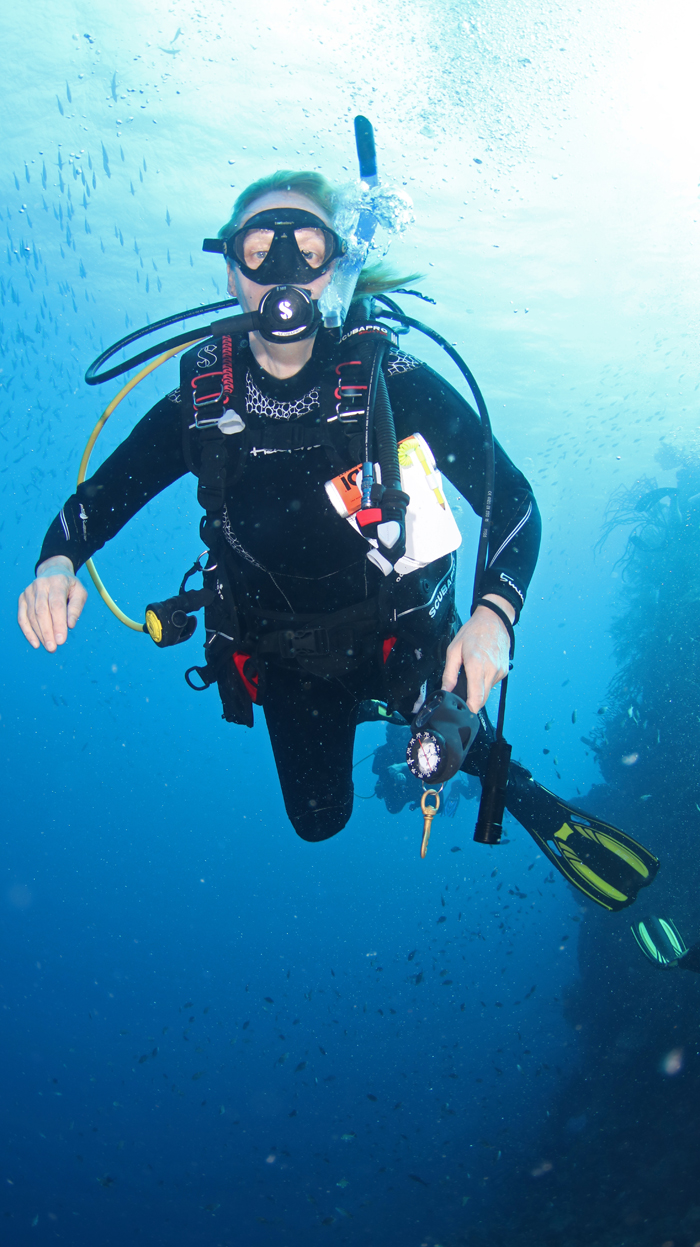
Photos courtesy Turtle and Ray. |
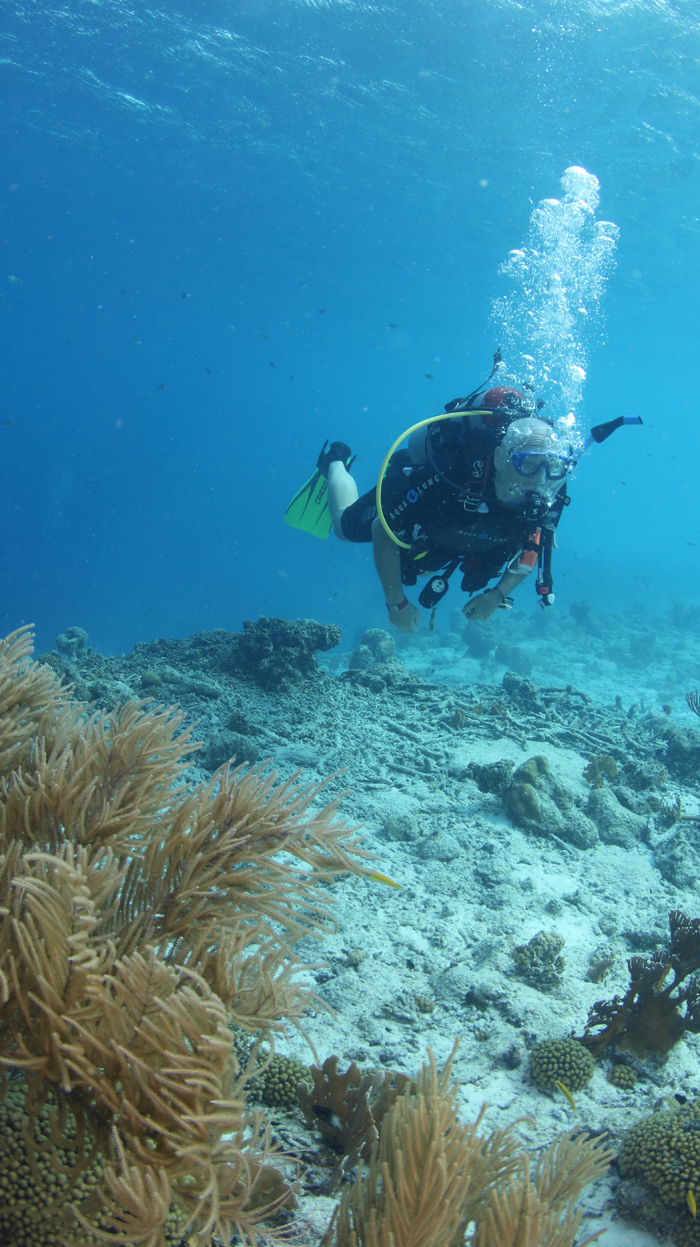 Photos courtesy Turtle and Ray. |
Mermaids
An absolutely unique opportunity presented itself the first afternoon. Diving with mermaids. Having demonstrated at least a modicum of bouyancy control during our morning lessons, I was trusted enough to dive in the group, and the mermaids were able to accept me as a volunteer for their photoshoot. Right by the hotel bar, the sand dropped away quickly enough that the dive boats could come passed only 20 feet away, which meant that if I got into serious trouble I'd still only be 15 feet down, and 20 feet from the shore. What could possibly go wrong?
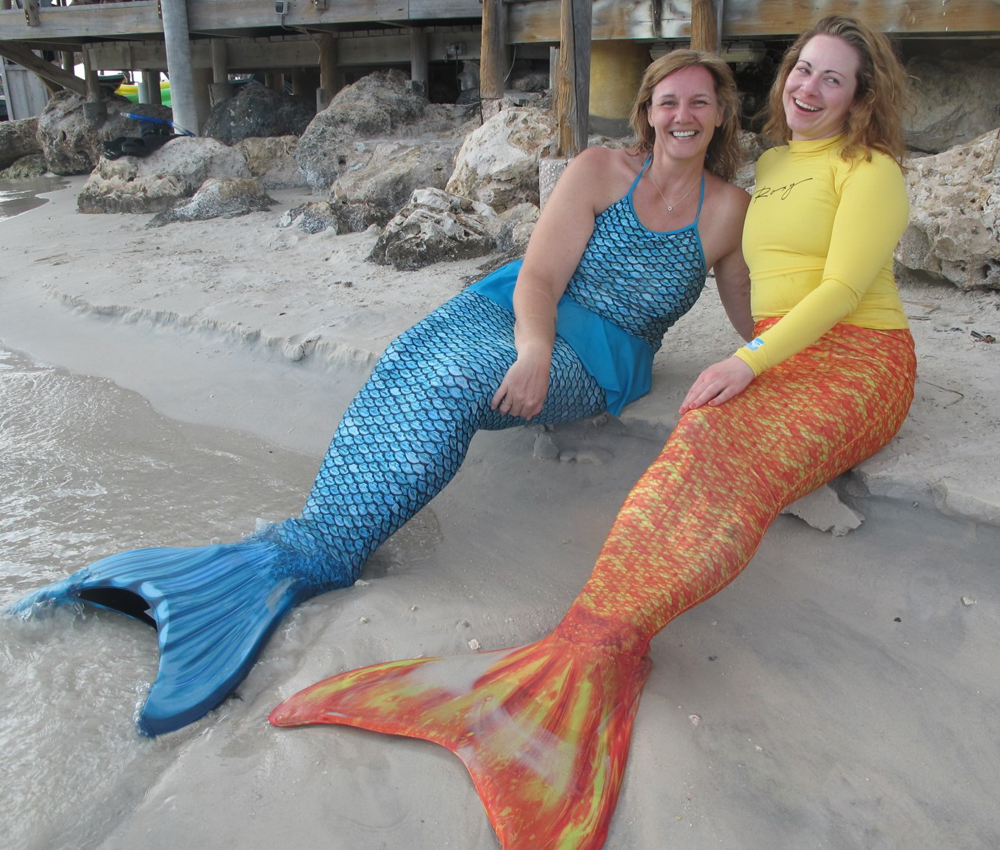 Photos courtesy Laura McCallion. |
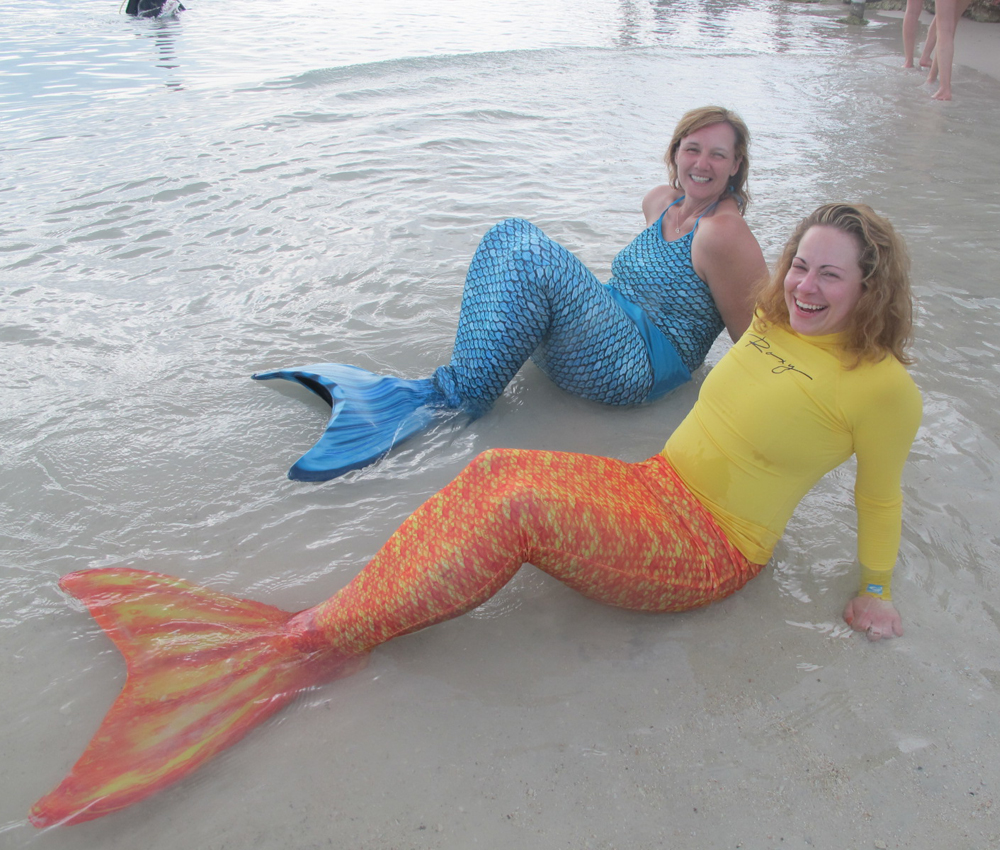
Photos courtesy Laura McCallion. |
It turns out that in the middle of the channel, in about 15 feet of water, there was a concrete garden bench. The goal was to photograph the mermaids sitting on the garden benches reading magazines. That meant that in addition to the two mermaids, they needed at least a photographer, a keeper of the magazines, and an air supply each. My job was to hide under the bench and supply the second mermaid with air when she called for it.
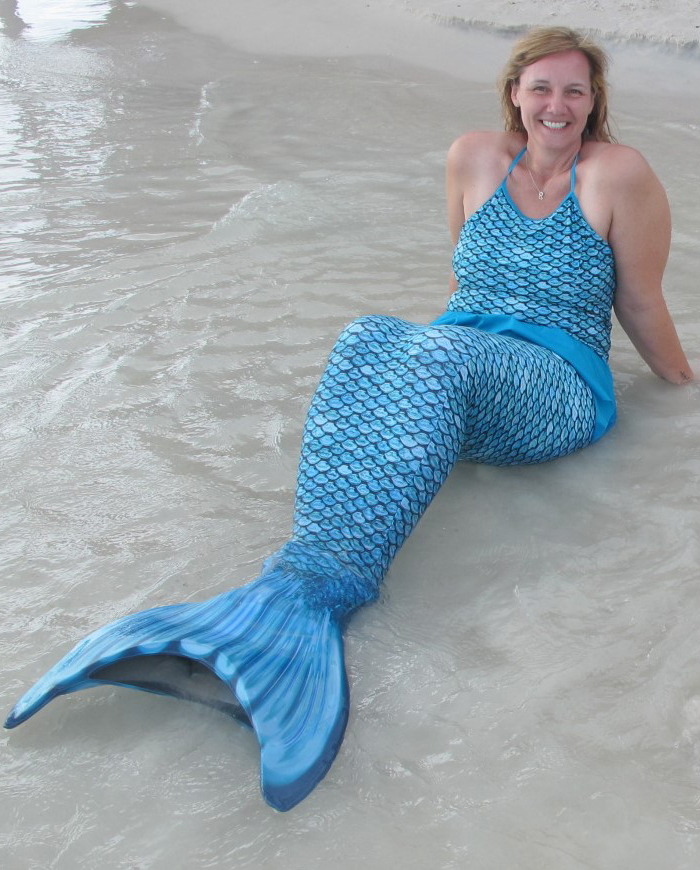 Photos courtesy Laura McCallion. |
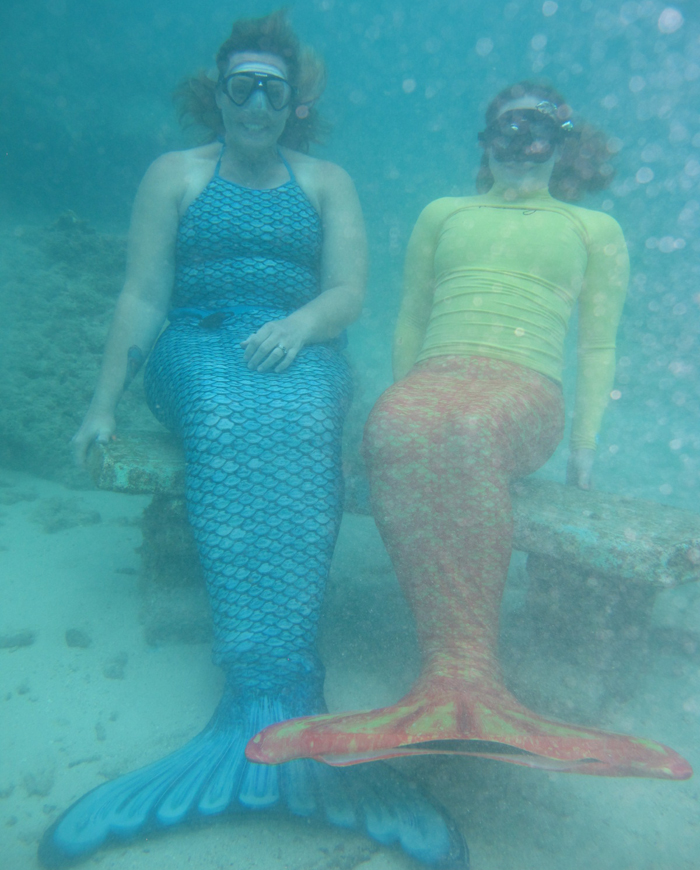
Photos courtesy Laura McCallion. |
Suiting up on the beach caused quite a stir. Wriggling into their one-legged mermaid skins right under the noses of patrons sitting at the bar was a photo op almost no one could ignore. Even folks on passing boats videoed the spectacle as they slide by. When the beach show was over we waded out and quickly disappeared under the waves.
To my amazement, the garden bench was a mob scene, and the mermaids flapped around on the surface while we waited for our turn. Finally, down they came. Instructor Laura/chief mermaid was a pro. She came right down, grabbed the bench, and started taking air from her accomplice. Apprentice mermaid Jesse had more of a struggle. Of course I blame myself too, but we struggled to find a rythym of her being able to hang on to the bench, and simultaneously grab and retain the regulator. Let's just say that with their lungful of air, mermaids are extremely bouyant. But after several trips back to the surface and down again (which for the same reason are very tiring) eventually we got settled long enough to hand out the magazines and the photographer snapped the shots. |
By the time we were done, others were queuing for some benchtime, but most were happy to wait, while they grabbed their own snaps—in some ways an even more fun trophy for them, since they just stumbled upon the mermaids by accident, as one is supposed to I think. And that was that.
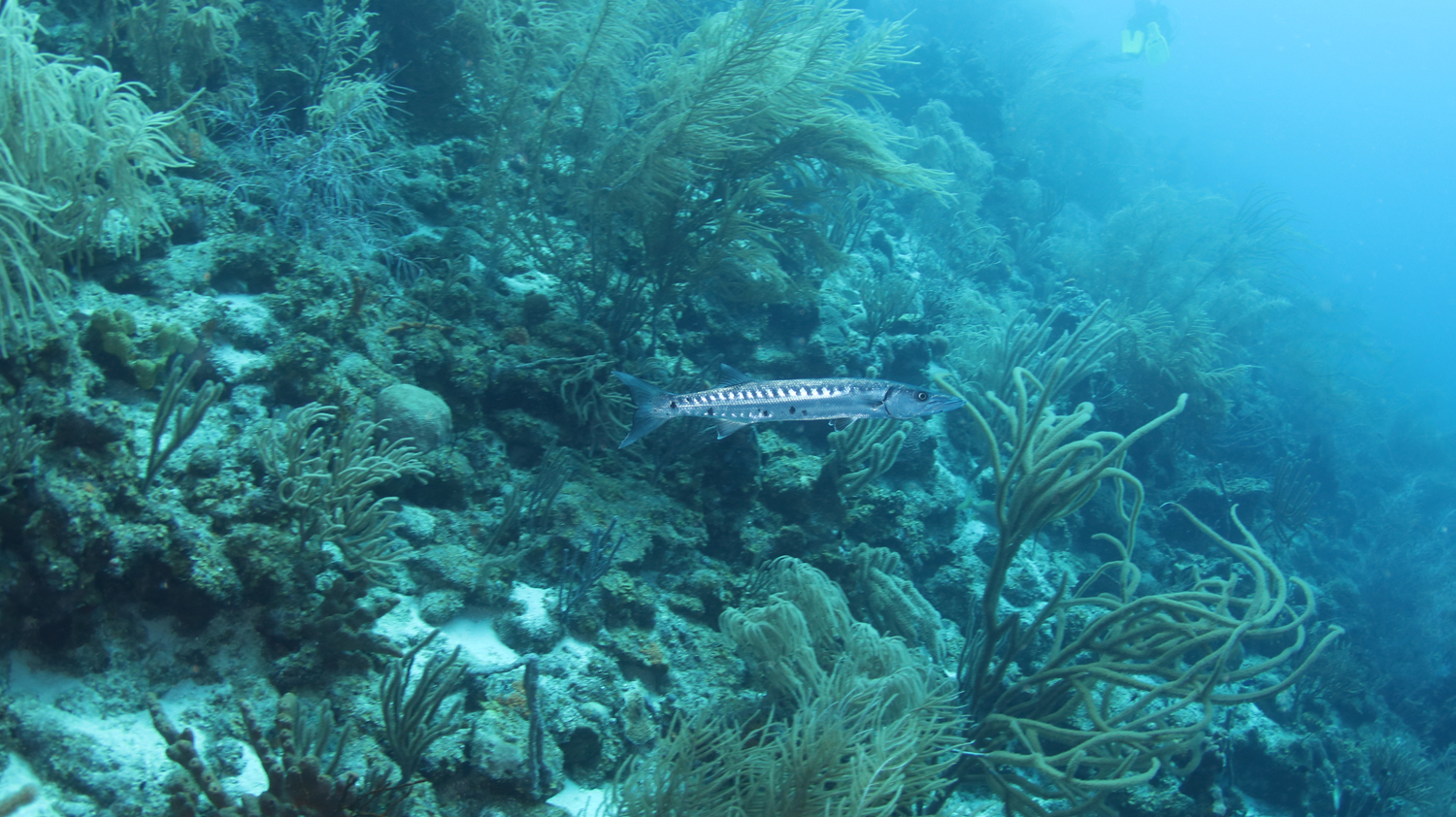
Young great barracuda. Photos courtesy Turtle and Ray.
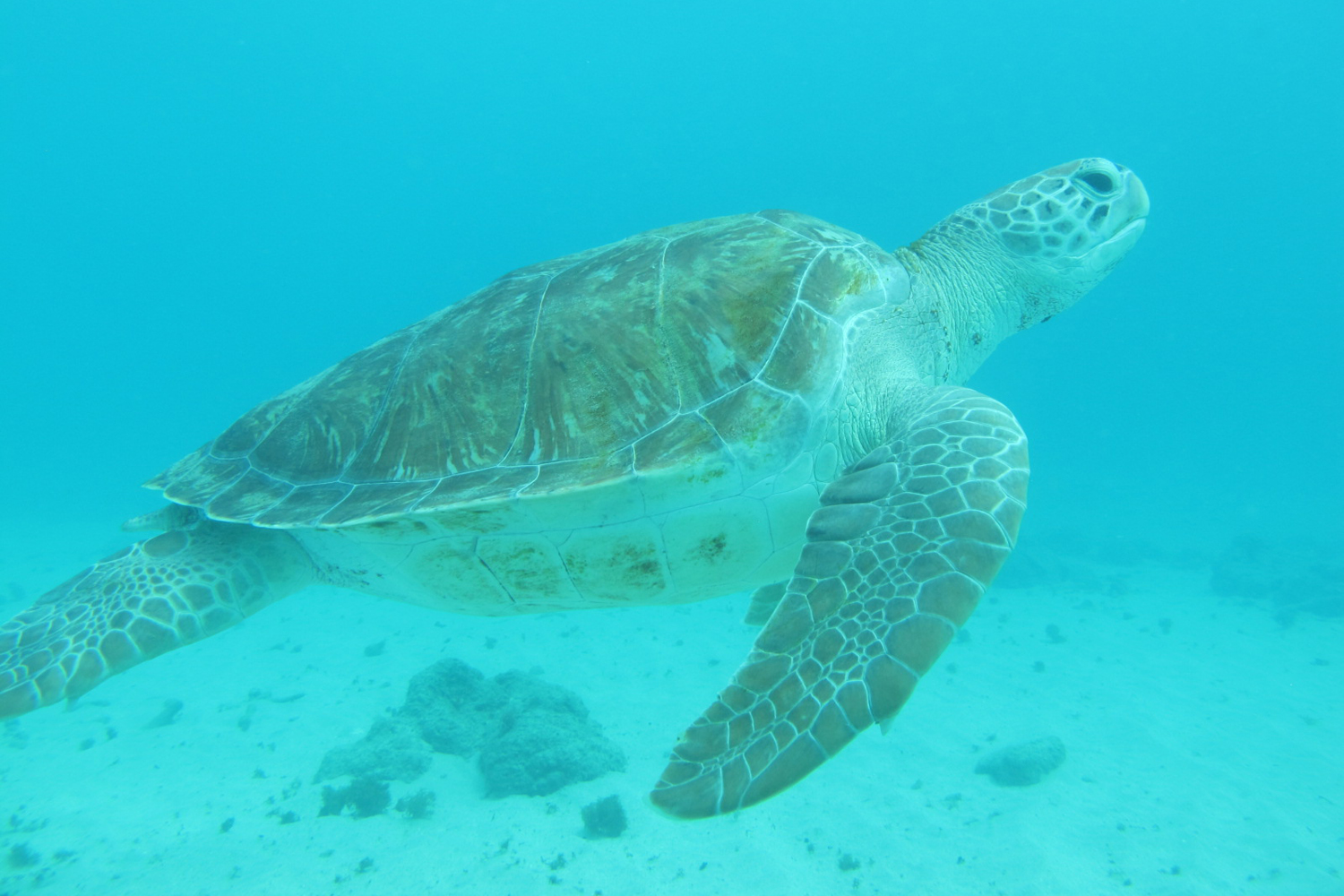
Green turtle. Photo courtesy Tom.
By Day 2, we were proficient enough to be invited out on the afternoon shore dive. This was very cool because of course not being certified meant that I was a liability (C decided to stay home and veg), and Laura definitely was, and deserved to be, off the clock. On the third day I even went out on the night dive.
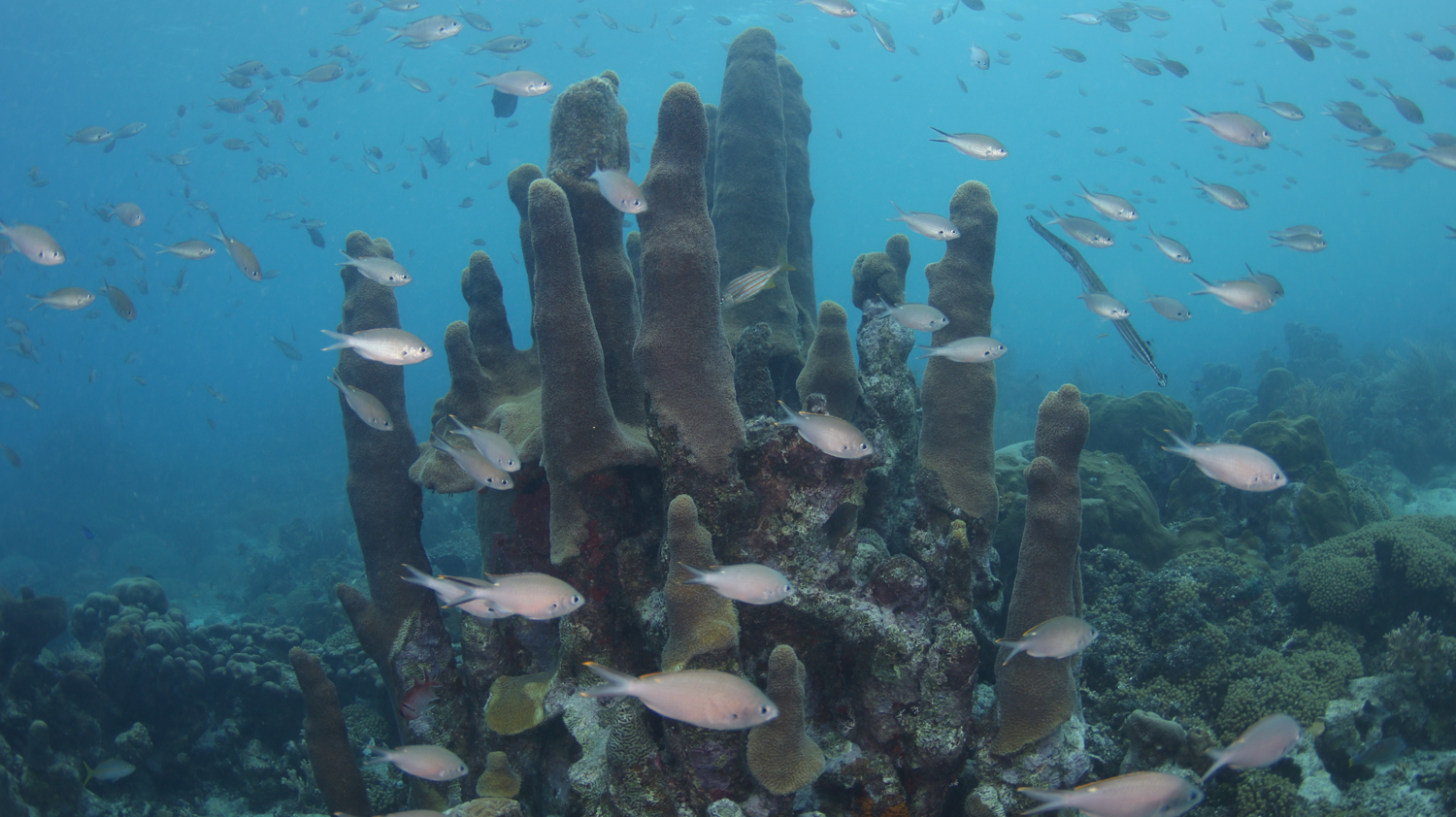
Mushroom Forest coral. Photo courtesy Turtle and Ray.
The dives were all splendidly different. Cliffs, a (very small) wreck, funky coral formations, a drift dive where the current is so strong that you drop in at one location and drift with the flow until the boat picks you up again somewhere downstream. To "guarantee" turtles, we went a long way north, and on the way home crossed paths with a dolphin pod. The captain killed the throttles and yelled "everyone overboard!" Then he set off again in a big circle. The dolphins went with him riding the wake and the bow wave, and he brought them right back passed the flock of snorkellers. Claudia loved it. On the surface they were right there, weaving above and below the waves. Underwater she could see half a dozen or more as they came by, almost close enough to touch. The true definition of swimming with the dolphins, the sort of thing that makes her heart sing. I was the only one who did not go in. We had a long way to go in the open water, and I maintained my position on the bridge, making sure the horizon did not move.
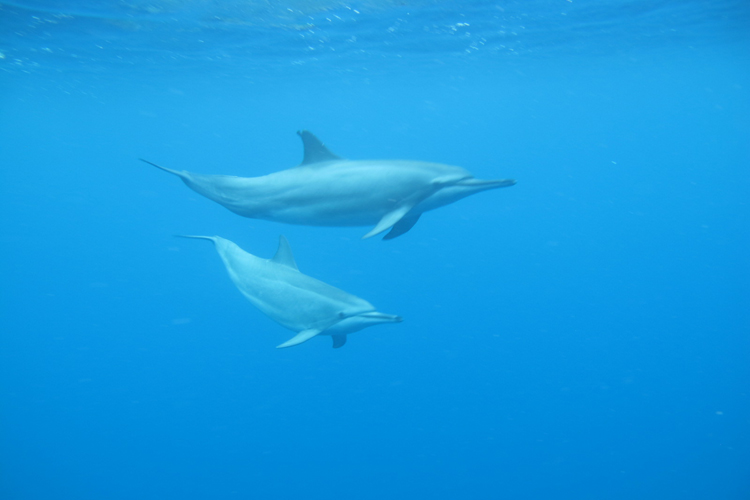 Bottlenose dolphins |
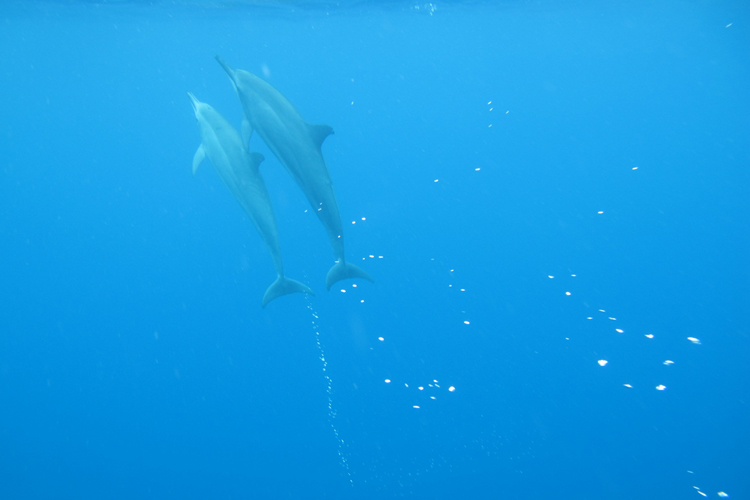
Photos courtesy Tom. |
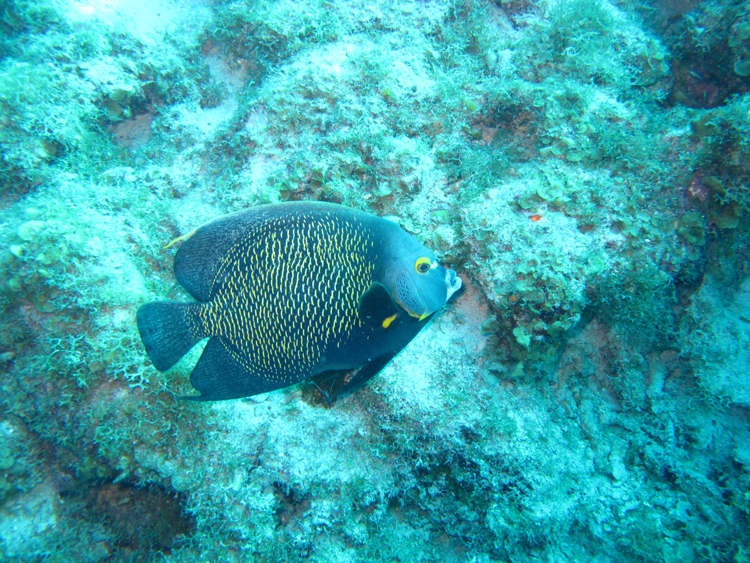 French anglefish. Photo courtesy Tom. |
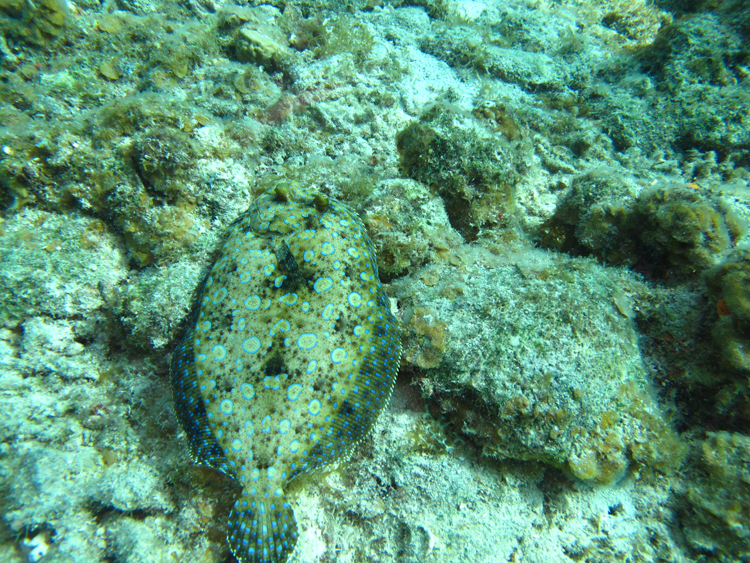
Flounder. Photo courtesy Tom. |
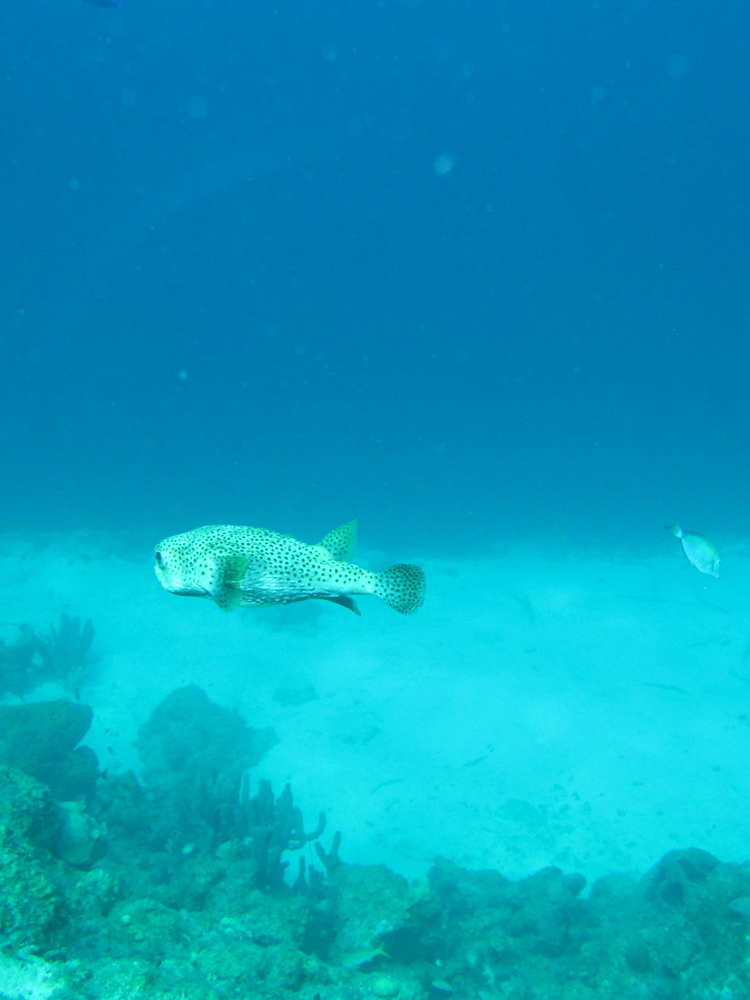 Porcupine fish. Photo courtesy Tom. |
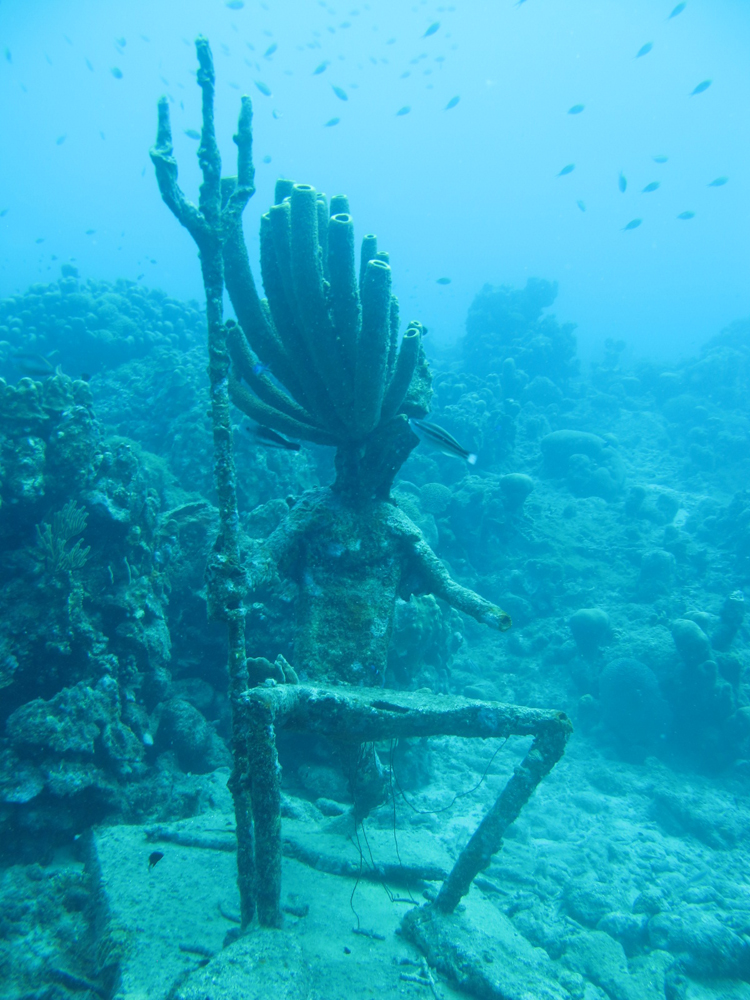
Poseidon. Photo courtesy Tom. |
Night
The night dive, which I worried about being creepy, was incredible. The lights worked brilliantly in every sense of the word. My biggest problem was keeping track of people. It's hard enough when everyone is in the same uniform, but in the darkness you can't even see that. Identifying people by their lights was totally beyond me at this stage. I had also not expected so much traffic, so it took me a long time to convince myself that the couple of divers I was tagging along with were not part of our group. Another time I found myself with no other lights in view. In open water this would have been a serious cause for concern, but we were 50 yards from the beach, and even if one completely lost one's orientation, surfacing immediately revealed the lights of home. I headed gently in that direction and soon caught up with Laura and her very recognizable camera and light rig. I spent a long time with her as she filmed her favorite, an octopus, squeezing in and out of tight spaces, camouflaging itself on open rocks and finally its shuddering motion as it apparently consumed a morsel it had found. Someone else took me over to a large boulder under which a nurse shark had crammed itself. A couple of free-swimming eels rounded out a splendid collection of sightings.
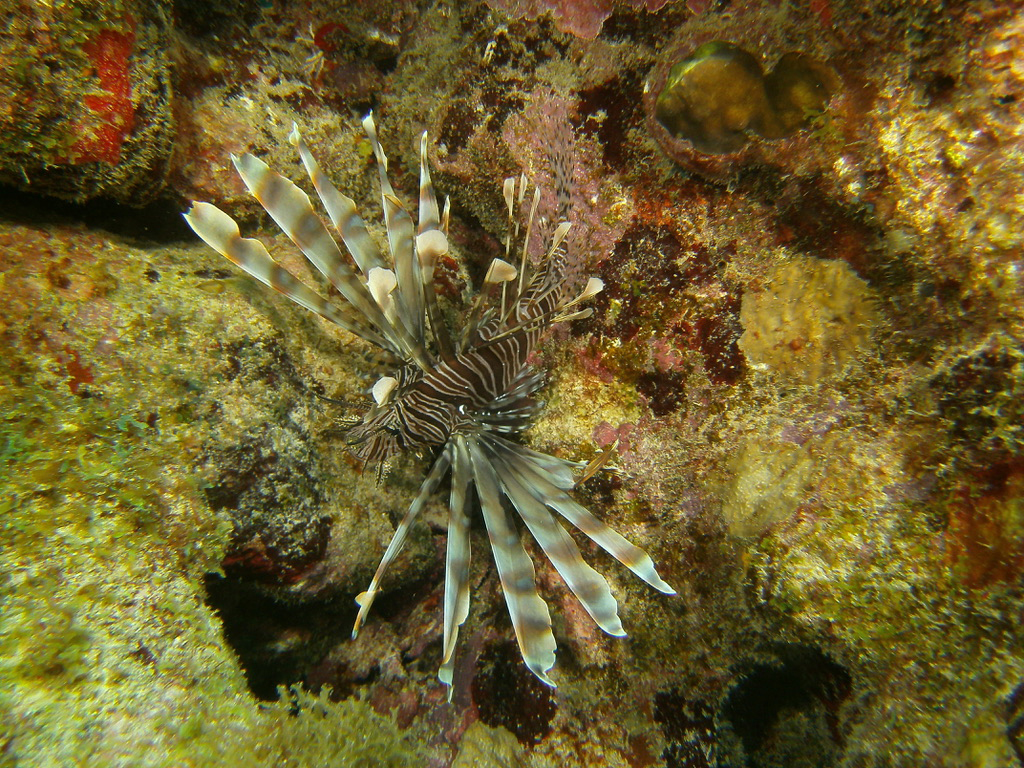 Lionfish. Photos courtesy Suzannne. |
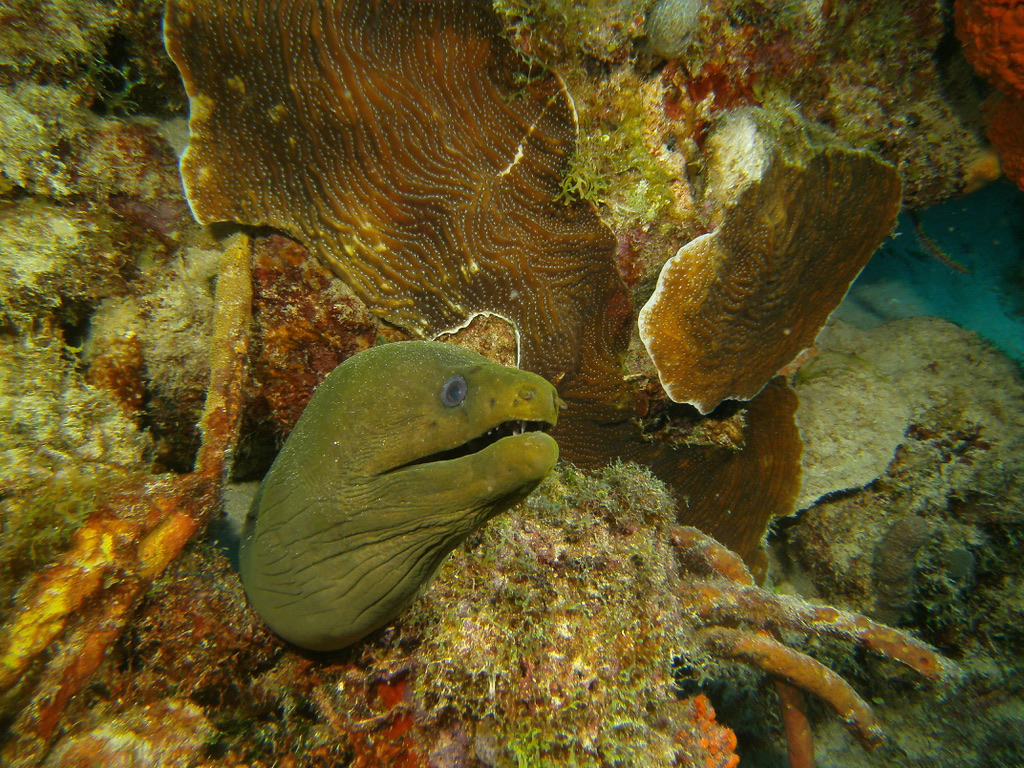
Green moray eel. Photos courtesy Suzannne. |
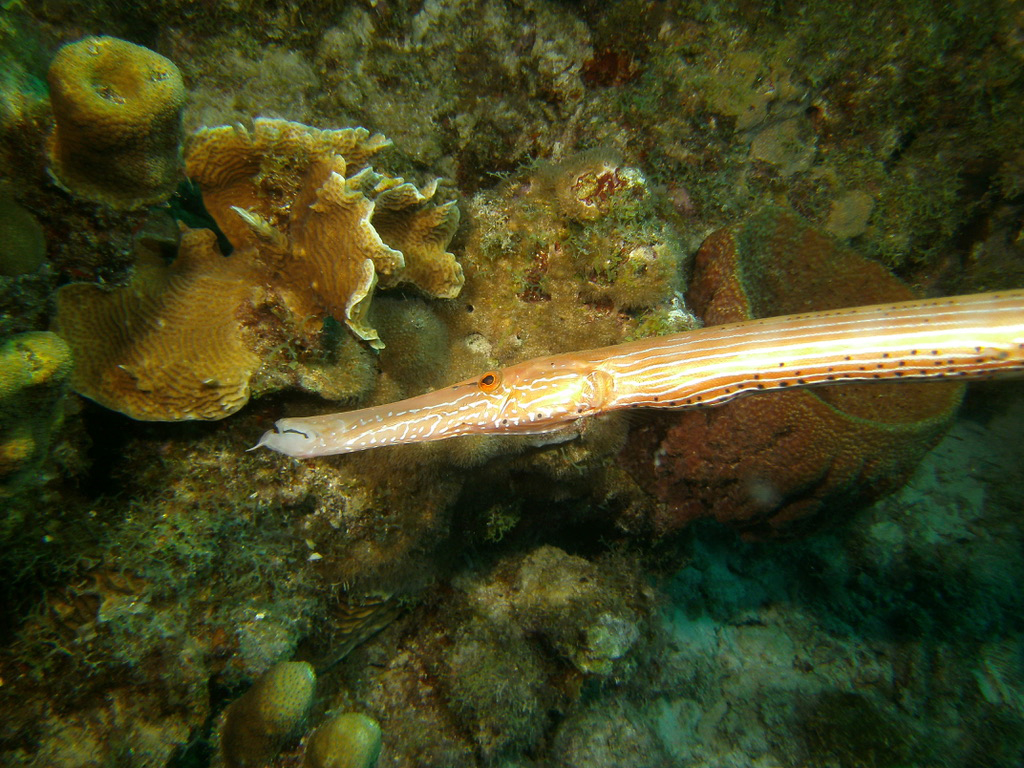 Trumpetfish. Photos courtesy Suzannne. |
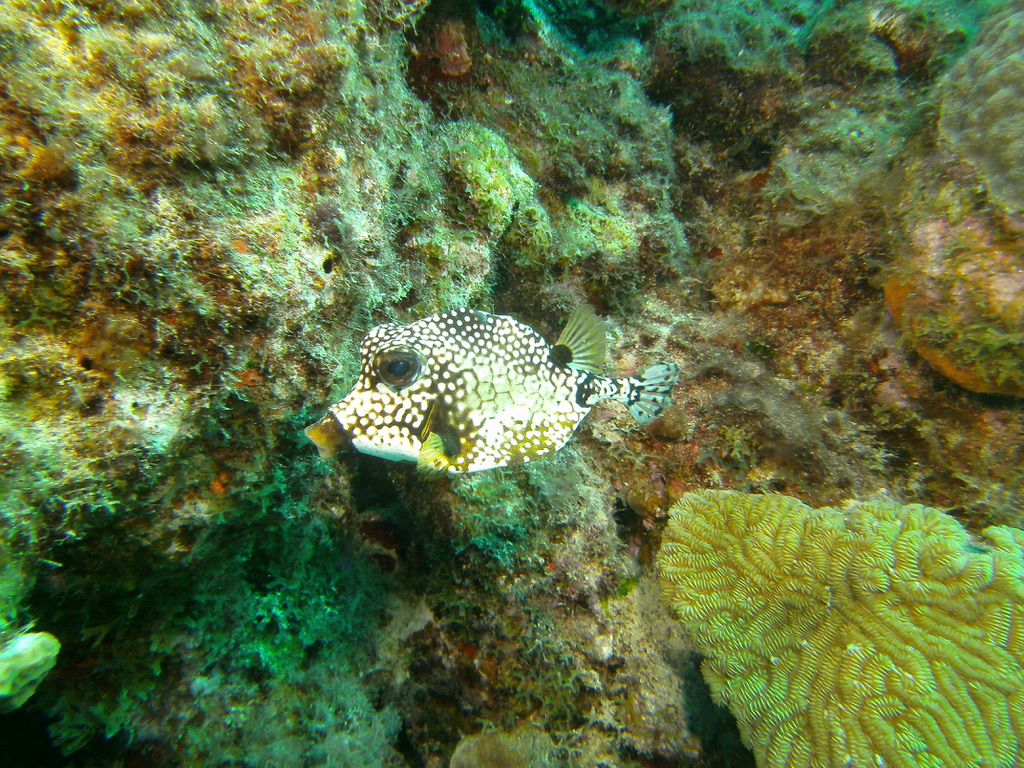
Spotted trunkfish. Photos courtesy Suzannne. |
Only once did I dance with the motion devil. We'd gone further than usual, in rougher conditions, and the dive site was decidely choppy. Call me a ninny, but under water I feel this persistant need to check that I can still breathe. Every few seconds I need to take another good long drag of reassuring air. For reasons that are a mystery to me, since I had heretofore assumed that this was a reptilian-level survival response, our fellow divers did not appear to need these checks. As a result my tank was always one of the first to empty, and therefore I was generally one of the first back on the boat. Meanwhile another member of our group who seemed to think he was on his own custom trip, was so much longer than everyone else that eventually the dive master had to return to the water and force him to surface. We steamed off to the next site as soon as his flippers hit the deck, but by then the damage was done. We were anchored off an island beach, and after muscling through the dive I dumped my gear and immediately snorkelled to the island and dragged myself through the surf and beached like a dying whale. I lay there so still, so long, with my fins pointing at the sky that a zodiac from a neighboring boat buzzed over to see if I was still alive. Eventually several other members of the group came ashore to check out the island for a while, and one of them brought me water that Claudia had sent along. When it was time to depart, the zodiac returned and generously volunteered to carry me back to the boat. The serious sunburn was a small price to pay for couple of hours on solid ground.
Video courtesy Laura McCallion.
But all week the wind was picking up steadily, so by Friday it was going to be a serious motion challenge. Discretion, valor and all that, and with honor well and truly satisfied, I called it quits. I'm delighted that Claudia went without me, everyone had a good time, amd most remarked how glad they were that I decided to stay home. You can read into the what you like.
Willemstad
So with a half a day to kill before being picked up by the airport bus, we scooted into Willemstad. Formerly the capital of the Netherlands Antilles prior to its dissolution in 2010, Willemstad has an estimated population of 150,000. The historic centre of the city consists of four quarters: the Punda and Otrobanda, which are separated by the Sint Anna Bay, an inlet that leads into the large natural harbour called the Schottegat, as well as the Scharloo and Pietermaai Smal quarters, which are across from each other on the smaller Waaigat harbour.

The city centre, with its unique architecture and harbour entry, is a UNESCO World Heritage Site. Punda was established in 1634, when the Dutch captured the island from Spain. The original name of Punda was de punt in Dutch. Otrobanda, which was founded in 1707, is the newer section of the city and is considered to be the cultural centre of Willemstad. Its name originated from the Papiamentu otro banda, which means "the other side."

Queen Emma Bridge
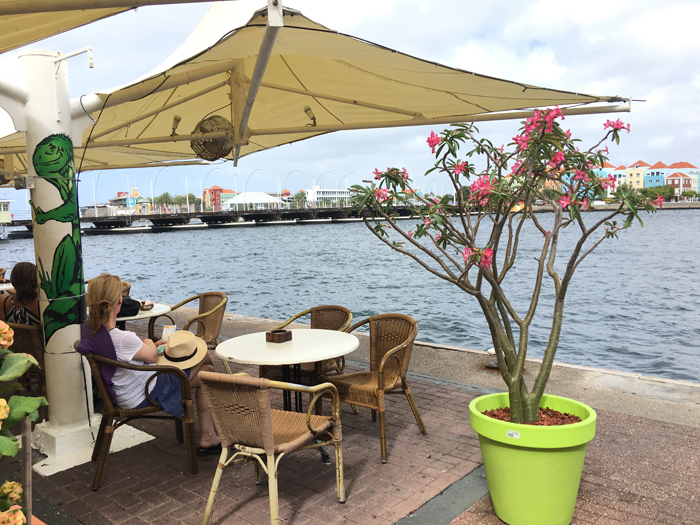
The Queen Emma Bridge is a 16-pontoon bridge across St. Anna Bay in Curaçao. It is the the world’s only floating wooden bridge. It connects the Punda and Otrobanda quarters of the capital city, Willemstad. The bridge is hinged and opens regularly to enable the passage of oceangoing vessels. On the opposite end from the hinge is a small shelter where an operator controls two diesel engines turning propellers. The propellers are mounted perpendicular to the length of the bridge and allow it to swing parallel to the shore. The process only takes a few minutes to complete. Originally it was a toll bridge. Between the years 1901 and 1934, if you were wearing shoes you had to pay 2 ANG cents to cross the bridge. Savvy pedestrians who wore shoes would take them off to dodge the toll, whereas proud poor pedestrians – who didn’t necessarily wear shoes on a daily basis – saved their shoes for making the crossing. They considered that crossing a special occasion and proudly paid their 2 cents. Locally, the bridge is known as "Our Swinging Old Lady" as it will swing to the Otrabanda side of Willemstad.
The bridge was originally built by American entrepreneur and US Consul Leonard B. Smith in 1888 and inaugurated on May 8th of that year. Smith is rumored to have come from Boston though I have not been able to corroborate that fact. He had the pontoons built in Camden, Maine and transported them to Curaçao by sailboat. The movable section was built in two parts on the Mötet wharf in the Saint Anna Bay. The bridge was completely renovated in 1939.
The bridge had an interesting sway to it which was a bit of a surprise considering how calm the body of water it spanned was, and I noticed that experienced crossers had developed a slightly waddling gait, and gently listed alternatively to port and starboard but by doing so kept up a brisk pace. But it was too much for Claudia who turned back happy to wait for me to return. |
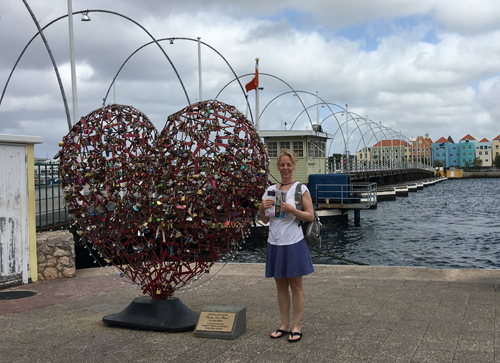 |
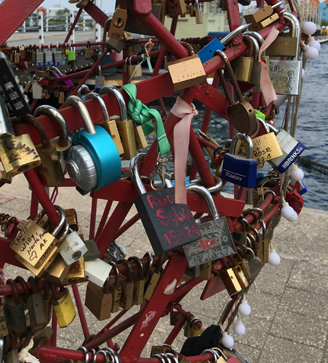
|
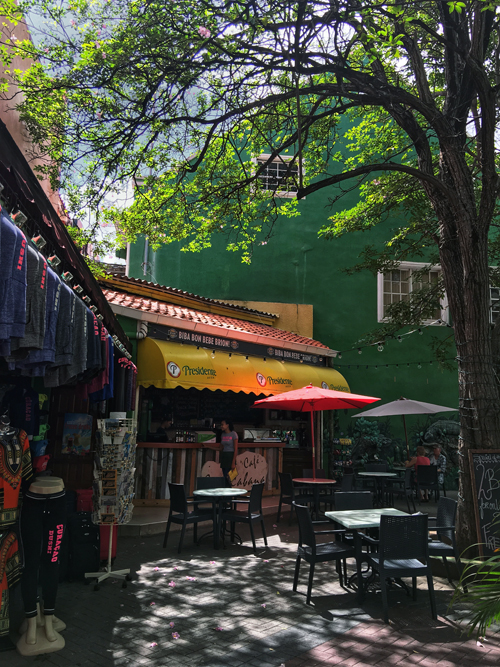
So I did not spend any time in Otrobanda not that we had a lot of time to spend, but I snagged the photos I wanted of the UNESCO-approved view, and weaved my way back across. Claudia had found a little cafe on the water front where we had an excellent expresso, and watched the bridge in action as it opened to let a boat through. Perfect. We wandered around town a little, poking our heads into a few stores, but there was a definite air of the place being on pause until nightfall. This little square was lovely, and reminded us of the south of France. We would happily have sat here for a while, but time was up. Time to return to the hotel and thence airport bus.
The Mikvé Israel-Emanuel Synagogue
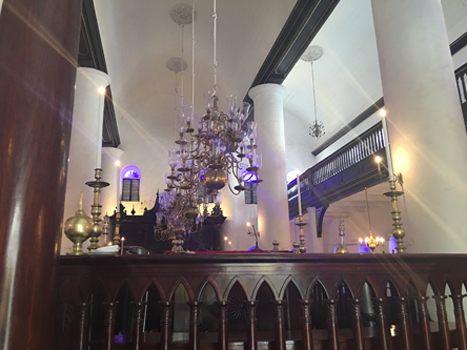
Mikvé Israel-Emanuel Synagogue
Willemstad is also home to the Mikvé Israel-Emanuel Synagogue (Hebrew: בית הכנסת מקווה ישראל-עמנואל; English: The Hope of Israel-Emanuel Synagogue), the oldest surviving synagogue in the Americas. It is commonly known as the Snoa (short for esnoga, an old Portuguese and Ladino word for synagogue). This was actually our first stop, and it is fortunate that it was, because it was actually closed to tourists (it was Saturday afterall). But the guard knew a good thing when he saw it, and made a big play of being able to give us a once-in-a-lifetimne, just-because-I-like-you, totally-against-the-rules, personal sneak tour. He definitely over-played it, but there was something at least a little special about just the three of us creeping in over the sand floor, peering around the corners, snapping a couple of pictures and beating a retreat. We gave him what it would have cost for the regular tour which he quickly trousered and then we were back on the street.
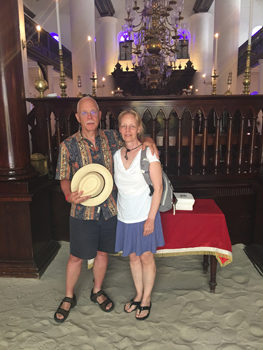
The community (congregation Mikvé Israel) dates from the 1650s, and consisted of Spanish and Portuguese Jews from the Netherlands and Brazil. In the nineteenth century there was a breakaway Reform community (Emanu El); the two merged to form the present community in 1964. The community is now affiliated with Reconstructionist Judaism.
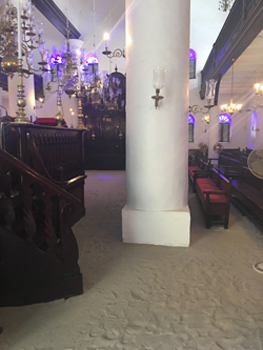
The first synagogue building was purchased in 1674; the current building dates from 1730. The sand floors remind congregants "of how its Jewish ancestors on the Iberian peninsula covered the floors of their makeshift prayer houses so that their footsteps would be muffled and the suspicion of potential denouncers would not be aroused." With its three high vaulted ceilings, the Holy Ark and the pulpit, the galleries, the benches and the chandeliers, the interior of the synagogue bears a marked resemblance to the Portuguese Synagogue in Amsterdam.
We spent no time exploring the island, and only this couple of hours exploring Willemstad, which normally would have been unthinkable, but here it seemed entirely appropriate. We came to dive, and to hang out with our new diving family, and we did just that. Diving and the meals with the divers is what I remember, and what great memories they are. No regrets.
